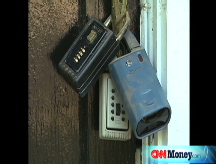The next building bust
Nonresidential construction held up as housing slumped. But a slowdown for offices, hotels and malls is looming, which could be another jolt to the economy.
 |
| Construction of offices, hotels, malls and other nonresidential buildings is poised to follow home building sharply lower the rest of this year. |
NEW YORK (CNNMoney.com) -- Demand for new homes collapsed last year. Next up could be a similar drop in the rest of the construction market -- and that could be the latest drag on an already sputtering U.S. economy
Nonresidential construction, which includes office buildings and retail centers, hotels and institutions such as schools, hospitals or government buildings, remained strong through much of 2007.
But a combination of the economic slowdown and tighter credit appears to be putting the brakes on nonresidential projects. Even if work continues on those projects already underway, there are signs that the pipeline of new construction is about to dry up.
"The trend is much weaker," said Kenneth Simonson, the chief economist for the Associated General Contractors of America, the trade group for contractors outside of single-family home construction. "My conversations with contractors show they're still quite busy. But their order books are shrinking and they're quite worried."
A slowdown in the entire construction market would be bad news for the economy. Investment in nonresidential buildings added an average of $250 billion to the economy every year since 1990. A downturn is also expected to lead to the loss of many well-paying jobs in the months ahead.
Economists say a fall-off in nonresidential construction in the face of an economic slowdown shouldn't be a surprise.
"Developers are a little nervous about getting enough rent, getting enough tenants so they're pulling back," said Jim Haughey, chief economist for Reed Construction Data.
What's more, Haughey said construction on some public infrastructure projects, such as highways and sewers, are being put on hold or slowed down as local governments struggle with declining tax revenue and tight budgets.
Industry tracker McGraw-Hill Construction reported that nonresidential construction starts had remained strong through February, then plunged 23% in March, the most recent month for which a reading is available.
Hotel starts tumbled 67% after the start of large hotel projects in Las Vegas and Atlantic City in February, while office construction was down 28% and store construction was off 18%.
McGraw-Hill Construction said the outlook isn't improving either.
"The tight lending environment will dampen the volume of commercial projects as 2008 goes on," said Robert Murray, chief economist for McGraw Hill Construction
Another troubling sign is that the Architecture Billings Index, a widely respected leading indicator of commercial construction from the American Institute of Architects, has been in a free-fall for several months. It hit a record low in March and has fallen more than 20% in the past three months.
"On the commercial side, best I can tell the problems are in all of it - offices, retail, hotels," said Kermit Baker, chief economist for the American Institute of Architects. "I think we will see a prolonged decline"
Baker said he's hopeful that the downturn will be limited since office vacancy rates are relatively low. But he said high prices for many basic materials, such as steel and copper will keep some projects on hold. A weak dollar and strong global demand for those products is keeping the prices high.
"We've seen construction material costs increase 6% to 8% [over a year ago] -- much faster than inflation," he said.
Inflation is also making the market seem healthier than it is. Haughey said higher material costs are masking the slump in nonresidential building because construction is measured by the dollars spent on projects. In other words, fewer structures are getting built but it's costing more to do so.
David Seiders, chief economist of the National Association of Home Builders, said problems in the residential mortgage market seem to have spread to the nonresidential construction sector as well even though there hasn't been a corresponding problem with rising defaults on those types of loans. He points out that the Federal Reserve's latest loan officer survey showed that tightening of credit in commercial real estate.
The survey found more than two out of three loan officers said their lending standards in the sector have tightened "somewhat" and another 10% have tightened them considerably.
"The degree of credit tightening going on there is very noticeable right now," said Seiders. "It's frozen up along with the private mortgage-backed security market."
Due to the strength of nonresidential construction, some builders and residential subcontractors last year were able to find jobs building offices, hotels and malls. Still, there has been an average of 32,000 job losses a month in the construction sector over the past 12 months.
And a slowdown in commercial construction will lead to even more construction job losses.
"The housing downturn is clearly not over, so this just seems like piling on at this point," said Seiders. ![]()




